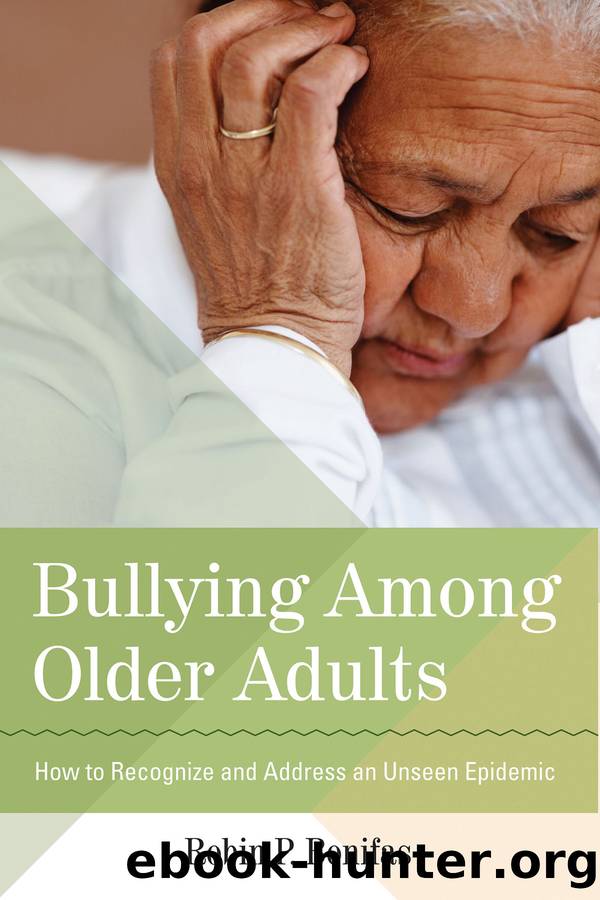Bullying Among Older Adults by Robin P. Bonifas

Author:Robin P. Bonifas
Language: eng
Format: epub
Publisher: Health Professions Press, Inc.
Published: 2016-07-25T00:00:00+00:00
PART III
Creating Caring Communities
CHAPTER 7
Bullying Assessment Strategies and Interventions
Eleanor Feldman Barbera
This chapter offers a comprehensive approach to preventing bullying among older adults in long-term care settings such as assisted living facilities and nursing homes. The section âAssessing the Situationâ examines strategies to assess, report, and track bullying within an organization, and the section âBullying Interventionsâ discusses three interconnected prevention interventions to minimize negative interactions. The first-level intervention trains staff and residents to identify bullying and to be âupstandersâ rather than bystanders when bullying behavior is observed. The second-level intervention uses recognition programs to reward positive interactions among residents. Lastly, the third-level intervention centers on involving long-term care community members in positive, pro-social activities to create a more empathic environment where older adults have less time for engaging in negative behaviors. Of the three, upstander training is the most crucial prevention strategy for the community.
Assessing the Situation: Conduct an Initial Assessment
A review of assisted living communities by Margaret Wylde, Ph.D., and the American Seniors Housing Association (Unlocking the Mystery of Very Satisfied Independent Living Customers: Make Them âFeel at Home,â 2014) found that bullying occurred in every community included in the study. Given this finding, bullying is likely present in your senior care organization as well. An assessment of the existence and extent of bullying within your community will help in targeting interventions to the exact nature of the relationship difficulties that exist among residents and participants.
Tool #1: Social Interaction Survey
The first part of the assessment process is gathering information from community residents using the Social Interaction Survey (see the Appendix). The survey asks questions about the types of bullying that are occurring, the locations, and the individuals involved, along with other pertinent information. Originally used with children in schools settings, the survey is adapted from the work of Rodney Pruitt, M.A., a consultant for school districts in west Texas in safety and drug-use prevention efforts. The assessment tool can be used as is or further adapted to the specifics of your organization. For example, if you suspect there may be a specific area in which bullies are targeting others, a question can be added about feelings of safety in that particular location. If your community has an active social media presence, a question might be included regarding bullying using those forums. This questionnaire is more comprehensive than the one presented in Chapter 4 (see Figure 4.4) in that it includes questions about where and when bullying behaviors occur, elicits residentsâ input on the bullying experiences of others as well as their own, and asks residents how they responded to negative behaviors. It is a good second-level assessment for organizations that are ready for more advanced understanding of the bullying behaviors occurring within their community.
It is important to consider readability when using written surveys with older adults, many of whom have difficulty reading small type and relatively ornate fonts. To increase the likelihood that your community members will be able to complete the questionnaire independently, use the following recommendations from the
Download
This site does not store any files on its server. We only index and link to content provided by other sites. Please contact the content providers to delete copyright contents if any and email us, we'll remove relevant links or contents immediately.
Application of a Novel Technique for Clinical Evaluation of Nitric Oxide-Induced Free Radical Reactions in ICU Patients by Unknown(696)
Rosenâs Emergency Medicine Concepts and Clinical Practice by Ron Walls; Robert Hockberger; Marianne Gausche-Hill; Timothy B. Erickson; Susan R. Wilcox(574)
Oxidative damage to surfactant protein D in pulmonary diseases by Vitality Starosta1 & Matthias Griese1†(410)
Social Science Perspectives on Global Public Health by Vincent La Placa & Julia Morgan(375)
Constructing Canine Consent; Conceptualising and Adopting a Consent-focused Relationship with Dogs by ERIN JONES(330)
Organic Chemistry: An Acid - Base Approach by MICHAEL SMITH(304)
ADVANCED EMERGENCY CARE AND TRANSPORTATION OF THE SICK AND INJURED by Unknown(272)
Saunders Nursing Drug Handbook 2024 - E-Book by Unknown(263)
Davis's Comprehensive Manual of Laboratory and Diagnostic Tests with Nursing Implications by Unknown(250)
Socio-Life Science and the COVID-19 Outbreak : Public Health and Public Policy by Makoto Yano; Fumihiko Matsuda; Anavaj Sakuntabhai; Shigeru Hirota(247)
Diagnostic and Statistical Manual of Mental Disorders, Fifth Edition, Text Revision (DSM-5-TR(tm)) by Unknown(246)
Human Microanatomy; Cell Tissue and Organ Histology with Celebrity Medical Histories by Stephen A. Stricker(245)
Berne and Levy Physiology E-Book by Unknown(237)
Replacing the Dead by Mie Nakachi;(232)
Handbook of Skin Disease Management by Jiyad Zainab;Flohr Carsten; & Carsten Flohr(229)
Access to Medicines and Vaccines in the South : Coherence of Rules and Policies Applied by the European Union Commission by Stephen Kingah(226)
Deep Learning and Medical Applications by Unknown(222)
The Pocket Guide to Sensorimotor Psychotherapy in Context (Norton Series on Interpersonal Neurobiology) by Pat Ogden(218)
Advances and Technical Standards in Neurosurgery by Unknown(215)
